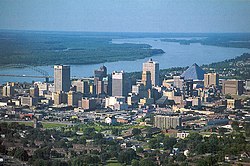| UTC time | 1865-08-17 15:00 |
|---|---|
| USGS-ANSS | ComCat |
| Local date | August 17, 1865 |
| Magnitude | 4.7 Mfa |
| Epicenter | 36°00′N89°30′W / 36.0°N 89.5°W [1] |
| Areas affected | Tennessee United States |
| Max. intensity | MMI VII (Very strong) [1] |
The 1865 Memphis earthquake struck southwest Tennessee near the Mississippi River in the United States on August 17 that year. Soon after the Mfa 5.0 earthquake hit, observers said the earth appeared to undulate and waves formed in nearby rivers. The force of the earthquake felled and cracked chimneys in Memphis and New Madrid, Missouri on the other side of the Mississippi. Shaking from the earthquake spread as far as St. Louis, Missouri; Jackson, Mississippi; and Illinois. [1] Apart from the 1811–12 New Madrid earthquakes, only three major events have struck the state of Tennessee, in 1843, 1865, and 1895. Several minor events have taken place as well.

